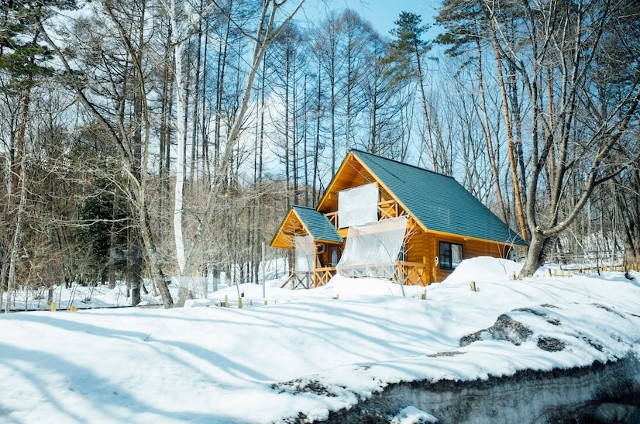As winter approaches, the drop in temperature brings a host of challenges for homeowners, particularly when it comes to maintaining the exterior of their houses. Cold weather can have a significant impact on different parts of a house, from the roof down to the foundation. In cities like Portland, this impact is quite evident. Portland experiences its coldest month in December, where average daily lows hover around 35 °F (2 °C), and daily highs rarely exceed 46 °F (8 °C). Additionally, Portland’s average annual snowfall is about 4.5 inches. These conditions make it crucial for homeowners to winter-proof their houses to ensure they are well-protected against the harsh weather. By investing in key exterior upgrades, you can safeguard your home, improve energy efficiency, and potentially save on future repair costs.
Upgrading to Weather-Resistant Siding
One of the most effective ways to protect your home from the harsh winter elements is by upgrading your siding. Weather-resistant siding is not only about enhancing the appearance of your home; it’s about fortifying it against cold temperatures, wind, rain, and snow. For residents in Portland, consulting a local Portland siding company can be beneficial. These companies understand the specific challenges posed by Portland’s climate and can recommend the best siding materials. So, look up the keyword Portland Siding Company near me to hire the right experts.
When choosing siding, it’s important to consider materials that are known for their durability and insulation properties. Options like vinyl, fiber cement, and insulated siding are popular choices. Vinyl siding is cost-effective and low maintenance, while fiber cement offers a blend of durability and aesthetic appeal. Insulated siding adds an extra layer of protection by helping to keep the warmth inside your home. Remember, the right siding not only protects your home but also can significantly reduce heating costs during the winter months.
Insulating Windows and Doors
Another critical aspect of winter-proofing your home involves insulating windows and doors. These are the primary areas where heat can escape, and cold air can infiltrate, leading to increased energy costs. Upgrading to energy-efficient windows and doors is a smart investment that pays off in the long run.
Look for windows and doors with good insulation ratings. Double or triple-glazed windows with inert gas fillings offer excellent insulation, keeping your home warmer in winter and cooler in summer. Additionally, proper sealing around windows and doors is crucial to prevent drafts. Weather stripping and caulking can be used to seal any gaps, ensuring your heating system works efficiently. This not only makes your home more comfortable but also lowers energy bills.
Roof Inspection and Repair
Your roof is your home’s first line of defense against winter weather. A well-maintained roof can protect your home from heavy rain, snow, and ice. Before winter sets in, it’s essential to have your roof inspected for any signs of wear or damage. Look for missing or damaged shingles, cracks, and leaks, and ensure that the flashing is intact.
If repairs are needed, it’s best to address them promptly. In some cases, an older roof may need a complete upgrade—materials like asphalt shingles, metal, or tile offer different levels of protection and longevity. A sturdy, well-insulated roof not only prevents water damage but also aids in retaining heat inside your home. Regular maintenance and timely repairs will extend the life of your roof and help avoid costly emergency repairs during the colder months.
Gutter Maintenance and Upgrade
The role of gutters in protecting your home, especially during winter, cannot be overstated. Gutters direct rainwater and melting snow away from your home’s foundation, walls, and basement, preventing potential water damage. Before winter arrives, it’s crucial to clean and inspect your gutters. Removing leaves, twigs, and debris ensures that water can flow freely and reduces the risk of ice dams forming, which can cause significant damage.
In some cases, upgrading your gutter system might be necessary. If your current gutters are old, leaky, or prone to clogging, consider installing newer, more durable materials like aluminum or copper. These materials can better withstand the rigors of winter weather and require less maintenance. Also, adding gutter guards can be a wise investment to prevent clogging and reduce the need for frequent cleaning. Well-maintained and efficient gutters play a critical role in keeping your home dry and safe throughout the winter season.
Sealing Cracks and Openings
Ensuring your home is airtight is another important step in preparing for winter. Cracks and openings around your home not only allow cold air in but also let warm air escape, leading to higher heating costs. Inspect your home’s exterior for any cracks or openings, especially around windows, doors, and where utility lines enter your home.
Sealing these gaps can be a straightforward DIY project. Caulk can be used for smaller cracks, while larger gaps may require expanding foam insulation or weatherstripping. It’s not simply about keeping the cold air out; it’s also about preventing moisture from entering your home, which can lead to mold and structural damage. By sealing these vulnerable areas, you enhance your home’s overall energy efficiency and comfort, making it a cozy refuge during the chilly winter months.
Landscape and Tree Maintenance
Your home’s landscape, particularly trees, needs attention as winter approaches. Trees laden with snow or ice can pose a risk to your home and safety. Heavy branches can break and fall, potentially damaging your roof, windows, and even power lines.
Before winter, inspect the trees around your home. Look for dead or weak branches that might fall under the weight of snow or ice. Trimming these branches can prevent potential damage. Additionally, consider the overall health of your trees. Weak or diseased trees might need more significant pruning or even removal.
Your landscape itself can also be prepared for winter. Protecting smaller plants with mulch or burlap can prevent frost damage. Also, ensure your yard slopes away from your home’s foundation to prevent water accumulation that can lead to foundation issues. Proper landscaping and tree maintenance not only protect your home but also maintain the beauty of your outdoor space.
Conclusion
Preparing your home for winter is an essential step in ensuring its longevity and your comfort. By focusing on key areas like siding, insulation, roofing, gutters, sealing, and landscaping, you can protect your home from the harsh winter elements. These upgrades not only safeguard your home but also contribute to energy efficiency and reduced maintenance costs. Remember, the effort you put into winter-proofing your home today can save you from costly repairs and discomfort in the future.


